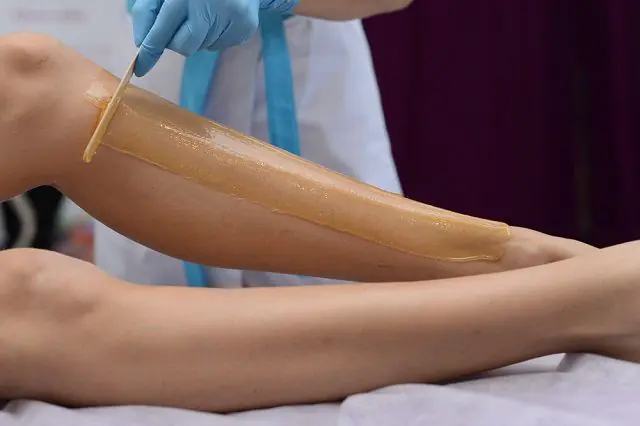
- What is folliculitis and sugaring
- Folliculitis after sugaring - how it happens
- Symptoms
- How to prevent
- Reasons for appearance
- Treatment options
- Folk remedies
- Prevention
Hair removal on the legs, intimate area and armpits using sugaring is one of the popular body care procedures, especially among women. However, if the procedure is performed incorrectly, this can cause the development of various skin irritations, one of which is inflammation of the follicles. Red pimples on the body, sometimes with purulent contents, itching and other complications after sugaring are unpleasant symptoms of folliculitis. Some women ignore these signs, but folliculitis can have serious health consequences. What are the reasons for the appearance of folliculitis after sugaring? How to prevent it and how to treat it? Let's look at it in detail in this article.
What is folliculitis and sugaring?
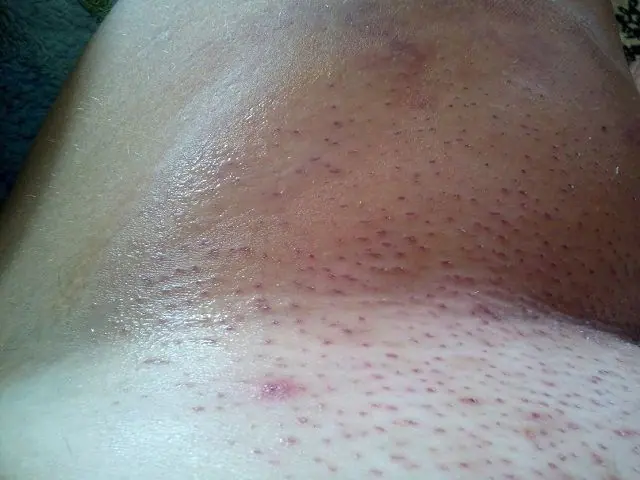
In the photo there is folliculitis after sugaring in the bikini area
Folliculitis is a purulent inflammation of the hair bulb (follicle). Sometimes accompanied by the formation of purulent contents. This is the most common complication after epilation, depilation, shaving, sugaring and other methods of removing body hair. Since hair extraction is a microtrauma to the skin, as a result, bacteria and infections enter the follicle, and humidity and lack of ventilation only accelerate the process of their spread.
Pathology can be superficial or deep. In the first case, small blisters with pus form, which open and disappear after a day. Deep folliculitis poses a health hazard, so the areas where hair is removed after the procedure must be treated with special products. Moreover, the appearance of folliculitis after hair removal can be caused by other reasons.
Sugaring is one of the methods of hair removal, which is performed using a thick sugar paste, which is a viscous caramel. It is distributed over the treated area of skin and removed with the hair. The color depends on the proportion of ingredients and can vary from light amber to the color of black tea. The consistency of the paste should be plastic so that it can be applied to the skin, but not too viscous so that it does not stick to your hands and is easily removed from the skin when torn off. To cook the paste, use sugar, water and citric acid/lemon juice. The procedure has advantages over other hair removal methods:
- Hypoallergenic. Since the composition of the paste is natural, the risk of allergic reactions is minimal.
- Efficiency. When hair is removed, mechanical trauma to the follicle occurs. After the first procedure, pigment is lost, the hair becomes softer, thinner and smaller.
- Safety. The temperature of the paste is 36–38°C, so it is impossible to injure the skin or get burned.
- Additional care. Since the sugar paste adheres to the skin, the dead skin cells of the epidermis are exfoliated during the procedure, which is a mechanical peeling.
Folliculitis after sugaring - how does it happen?
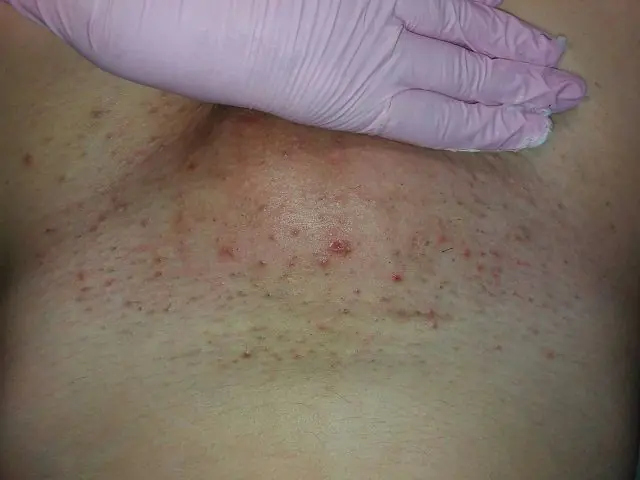
Photo of folliculitis after sugaring in the bikini area
Hair follicles are narrow channels in the skin from which hair grows. The human body is a system of blood vessels that are interconnected. Hair follicles are conduits for sebaceous glands that produce sebum, which creates a lipid coating on the surface of the skin. It is what neutralizes harmful bacteria and prevents them from penetrating into the deeper layers of the skin, that is, it protects the skin from irritation. During hair removal, the lipid layer is disrupted and the opening of the hair follicle is damaged. Microbes penetrate into them and the follicles become inflamed.
- Read also: is folliculitis transmitted from person to person?
Symptoms of folliculitis after sugaring

In the photo, fliculitis after sugaring on the legs
Diagnosis of folliculitis after hair removal is simple. The disease can appear on all parts of the body that have been treated. As a rule, folliculitis appears the very next day after sugaring. Its symptoms are always pronounced. After sugaring, pathogenic microorganisms at the site of hair removal cause itching; characteristic pimples with a red frame appear around the inflamed follicle, which during the inflammatory process form into yellow blisters with pus. After 2-3 days, the formed bubbles open on their own, and a crust remains in their place.
Typically, such complications arise due to ingrown hairs, which are quite common after sugaring. After hair removal, the skin becomes rough, and the new growing hair becomes thinner. Because of this, it is difficult for him to break through a thick layer of skin. It bends and grows. Often the pathological process moves from one hair follicle to another, which causes damage to large areas of the skin. To prevent hair from growing into the skin, and, as a result, folliculitis does not occur, you need to follow preventive measures:
- The day before sugaring, you should not use exfoliating scrubs, sunbathe or exercise.
- Do not use creams or lotions before the procedure.
- It is recommended not to carry out the procedure while taking antibiotics and menstruation.
- Before the first procedure, stop shaving your hair 7-10 days before the procedure.
- Hair should be removed only according to growth, and not against the hair.
- It is prohibited to perform sugaring for any skin diseases, severe tanning, epilepsy, papillomas, hematomas.
How to prevent the appearance of folliculitis after sugaring?

It is known that it is better to prevent than to treat, especially since folliculitis can become chronic. If folliculitis regularly occurs after the sugaring procedure, then you need to follow the basic rules of hygiene and preventive measures:
- Disinfect the skin before and after sugaring. This will reduce the risk of infections.
- Hair removal deprives the surface layer of the skin of moisture, which leads to water loss. This creates favorable conditions for the development of infections. Therefore, after the procedure and disinfection of the skin, it needs to be moisturized with lotions or oils. Almond-based products help especially well.
- Peeling will prevent the appearance of ingrown hairs. Use a horsehair mitt to smooth your skin while you shower. This way, eliminate dead cells and the layer of skin that prevents hair from coming out.
- Do not use cosmetics with artificial colors, substances and preservatives. They irritate the skin and make it susceptible to bacterial infections.
If the hair has grown into the skin, then to remove it, you need to steam the affected area and rub it vigorously with a natural washcloth. The hair follicle will open and the hair will come out. A scrub is also a good remedy for ingrown hairs. If the hair has grown very deeply, then it is not recommended to remove it yourself, so as not to cause harm.
- See also how to reduce irritation after hair removal
Reasons for the appearance of folliculitis after sugaring
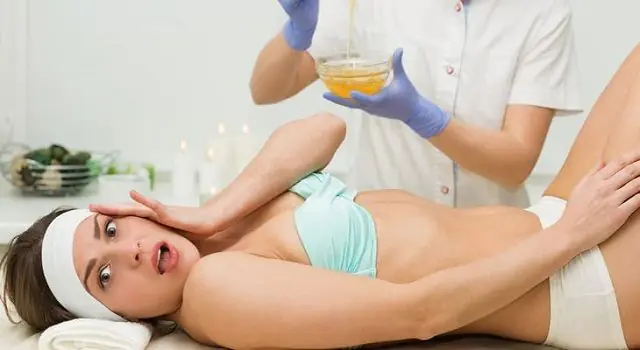
The most common cause of folliculitis after sugaring is excessive hair removal. But there may be other reasons. The inflammatory process does not occur in everyone who removes hair with sugaring. The cause of folliculitis in this case may be:
- Incorrectly carried out procedure.
- Carrying out a procedure for a client with excessive sweating.
- During sugaring, the client was taking antibiotics or had a strong tan.
- Within 1–2 days after the procedure, the client visited the pool, saunas/baths.
- No disinfection measures were carried out.
See also the causes of bacterial folliculitis.
Methods for treating folliculitis after sugaring

Treatment of folliculitis after sugaring can be done at home. But it is better to consult a dermatologist so that he can determine the cause of the development of the pathological process. Treatment of folliculitis can be conservative or surgical, it depends on the severity of the inflammatory process; in some cases, opening the abscess may be required. In most cases, they are limited without surgery. Typically, therapy for folliculitis after sugaring in the initial form of the disease consists of treating the affected area with alcohol solutions (fucorcin, brilliant green, 2% camphor or salicylic alcohol). Ointments and creams are also used. The following remedies have proven themselves well in the treatment of purulent-inflammatory skin processes.
- Elon ointment improves blood microcirculation in the affected area, has an anti-inflammatory and disinfectant effect, and accelerates the dissolution of purulent contents at the site of inflammation.
- Ichthyol ointment is used for applying bandages and applications to lesions.
- Dalacin-T gel is intended for treating areas 2 times a day.
- Azelaic acid is applied for 20 minutes, covering the top with a film.
Depending on the severity of the inflammatory process and symptoms, the dermatologist prescribes local therapy:
- Antibacterial ointments (Zinerit, Lincomycin, Erythromycin, Epiderm) and tablets (Doxycycline, Erythromycin, Cephalosporin).
- Increasing immune defense (immunomodulators Immunal, Vitaferon, Timalin).
- Antiallergic drugs to reduce itching (Suprastin, Claritin, Lomilan).
- In rare cases, antibiotics are prescribed (Levomekol ointment, erythromycin, synthomycin or Dermazolone, Clarithromycin, Amoxiclav tablets).
Folk remedies for the treatment of folliculitis after sugaring
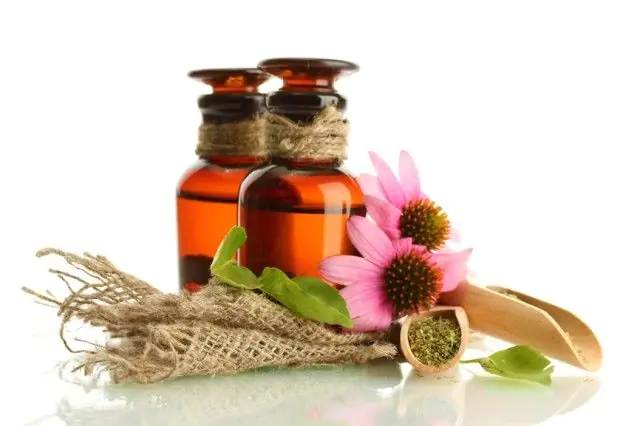
Natural remedies can be used for superficial folliculitis, but only in conjunction with medications. Herbs and plants provide a good healing effect, relieve itching and help eliminate the problem as quickly as possible.
- Garlic - an effective antibacterial agent. It is enough to eat three slices a day. Please keep in mind that eating garlic for a long time will lead to bad breath and skin, diarrhea and vomiting.
- Echinacea - a plant with antibiotic properties. It is taken 1-2 tablets per day between meals.
- Mallow effective calming effect due to the content of flavonoids, mucus and tannins. A steep decoction is made from the leaves and flowers of the plant, which is used to lubricate sore spots to eliminate inflammation, itching and irritation of the skin.
- Bergamot essential oil has an antibacterial effect. It is applied in a thin layer to clean skin.
- Decoction of calendula flowers treat lesions three times a day.
- Sweet woodruff leaves mixed with sour cream in equal proportions (1 tablespoon each) and applied to the inflamed areas for 20 minutes 3 times a day.
- Decoction of common dandelion leaves supports and strengthens the immune system. 2 tsp. plants are poured with 200 ml of water, boiled for 10 minutes, cooled, filtered and the decoction is taken during the day for 5–7 days.
In combination with medical and folk remedies, skin diseases after sugaring are treated with physiotherapy. High efficiency is observed: UV irradiation, polarized light, ultraphonophoresis. Good results when using: magnetic therapy, low-intensity UHF therapy, dry heat and carbon dioxide laser.
- Read more about the treatment of folliculitis with folk remedies
Prevention of folliculitis after sugaring
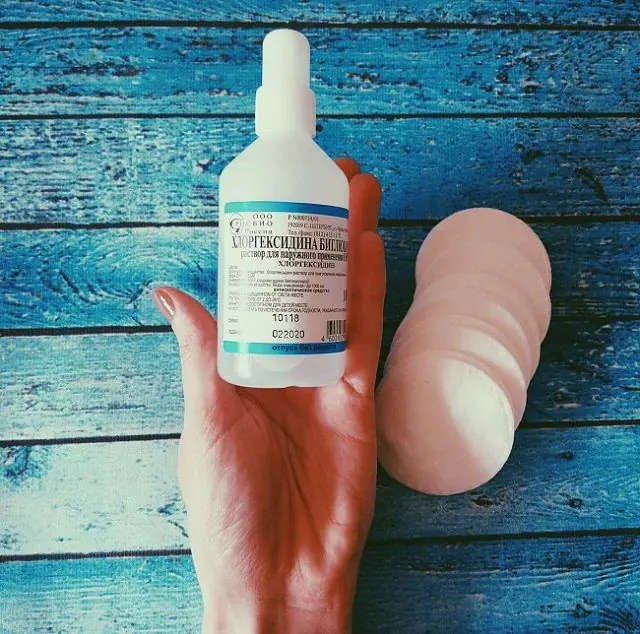
It is possible to prevent the development of the inflammatory process after sugaring. To do this, follow the following recommendations:
- You cannot take hot baths, visit saunas or swimming pools.
- Carry out hygiene procedures in affected areas using antibacterial soap.
- To disinfect the skin, wipe/rinse pathological lesions twice a day with Chlorhexidine.
- Wear loose clothing and underwear made from natural materials.
- If you suffer from sweating, then follow the rules of personal hygiene: change bedding and clean clothes more often, use a separate towel and personal hygiene items.
- Choose a certified specialist and clinic with permission to conduct such activities.
- When folliculitis appears after sugaring, the first thing to do is to stop any hair removal process.
- Maintain proper nutrition: reduce the consumption of animal fats with sweet carbohydrates, and increase foods containing protein, plant fiber, bran and vitamins.
- Wash your face with cool water, as hot temperatures stimulate sebum production.
Video about the prevention of folliculitis after sugaring:
- Related article: main differences between folliculitis and boils



